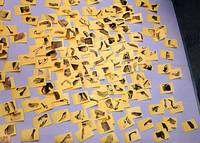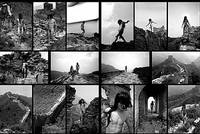Monday, August 09, 2004
Photography from East to West
I’ve been taking advantage of the quiet summer in Chelsea to catch up on uptown museum shows I haven’t had the chance to view. This weekend I went to the International Center of Photography and the Asia Society and Museum to see their shared exhibition, Between Past and Future: Photography and Video from China.
To people who look at a lot of contemporary American art, the works in this show will feel very familiar. The photos and videos in these installations include all the hallmarks of current domestic photographic practice—documentation of performative action and creation of elaborately staged scenes. They also display a deeply seated concern with the body and identity.
This last area, though, is where the work begins to depart from the familiar. Instead of filtering identity through race, class, and gender, these artists tend to explore issues of identity through the lenses of political ideology (specifically the legacy of the Cultural Revolution—the era during which most of them grew up) and China’s drastic societal change of the last two decades.
It may not be a stretch to claim that no human culture (except those that have experienced genocide) has undergone a more fundamental transformation in such a short period of time as Chinese culture has since the mid-1980s. That transformation, and the physical and psychological dislocations it has caused, is seen in much of the work shown here.
Pieces selected for the exhibition have been categorized according to four themes. Two themes are shown at ICP and two at the Asia Society. ICP presents “People and Place” and “Performing the Self” while the Asia Society hosts “Reimagining the Body” and “History and Memory.” The Asia Society’s portion is much smaller than ICP’s (works are contained in a single small Asia Society gallery), but the works shown at the Asia Society tend to be more engaging and compelling than those at ICP. For the interested viewer on a budget (yes, it does require two separate admissions to see both parts of the show), a personal preference for quality vs. quantity should determine which half to see.
 Although I’ve just aligned the ICP’s portion of the show with quantity, that doesn’t mean there’s an absence of quality work on display. The floor devoted to “People and Place” contains several works that highlight the rapid transformation of China’s urban landscape. Wang Jinson’s City Wall is five panels containing 1000 small photographs shot from a car as he drove around urban locations. Recent buildings, anonymous high rises for the most part, are presented as black and white images. Strewn among the homogeneity are occasional color snapshots showing traces of the ancient structures that are rapidly disappearing. These buildings and architectural details pop out of their black and white context like surprise glimpses of something unique caught from the corner of the eye.
Although I’ve just aligned the ICP’s portion of the show with quantity, that doesn’t mean there’s an absence of quality work on display. The floor devoted to “People and Place” contains several works that highlight the rapid transformation of China’s urban landscape. Wang Jinson’s City Wall is five panels containing 1000 small photographs shot from a car as he drove around urban locations. Recent buildings, anonymous high rises for the most part, are presented as black and white images. Strewn among the homogeneity are occasional color snapshots showing traces of the ancient structures that are rapidly disappearing. These buildings and architectural details pop out of their black and white context like surprise glimpses of something unique caught from the corner of the eye.
Working with the same theme, Zhang Dali paints graffiti-style heads on old buildings marked for demolition to make way for new construction. He then cuts out the form with a chisel and photographs the result. In his work we see either the new urban landscape or another historic building destined for destruction framed through the face-shaped aperture.

At the Asia Society Xu Zhen includes a piece in the “Reimagining the Body” section that uses Post-it Notes printed with black and white fragments of the body (obtained from pornographic Internet sites) to comment on the disintegration of the individual as a result of the information age that has swept through China and the western world. The curatorial note next to the work encourages viewers to move the hundreds of individual pieces around to new locations on the wall, creating a new order from the fragmentation that exists without bringing any sort of unity to the whole. The work highlights the state of dislocation experienced by individuals in a society that has undergone a wholesale psychological and physical transformation during a single generation.

Ma Liuming places this societal transformation in the broader context of Chinese history. Embodying a female alter-ego (Fen-Ma Liuming), the artist strips naked, effectively becomes a transgendered individual, and walks along remote portions of the Great Wall. The history and solidity of the wall is contrasted with the fragility and transitory nature of the individual in a contemporary society that has undergone significant transformation.
The exhibition (on display in New York through September 5, 2004 and then traveling to Chicago, Seattle, Berlin, and Santa Barbara) presents a first view for many in the west of what several critics and scholars believe will be the next frontier for the avant-garde during the twenty-first century. It’s an opportunity that shouldn’t be missed for those who care about contemporary art.
To people who look at a lot of contemporary American art, the works in this show will feel very familiar. The photos and videos in these installations include all the hallmarks of current domestic photographic practice—documentation of performative action and creation of elaborately staged scenes. They also display a deeply seated concern with the body and identity.
This last area, though, is where the work begins to depart from the familiar. Instead of filtering identity through race, class, and gender, these artists tend to explore issues of identity through the lenses of political ideology (specifically the legacy of the Cultural Revolution—the era during which most of them grew up) and China’s drastic societal change of the last two decades.
It may not be a stretch to claim that no human culture (except those that have experienced genocide) has undergone a more fundamental transformation in such a short period of time as Chinese culture has since the mid-1980s. That transformation, and the physical and psychological dislocations it has caused, is seen in much of the work shown here.
Pieces selected for the exhibition have been categorized according to four themes. Two themes are shown at ICP and two at the Asia Society. ICP presents “People and Place” and “Performing the Self” while the Asia Society hosts “Reimagining the Body” and “History and Memory.” The Asia Society’s portion is much smaller than ICP’s (works are contained in a single small Asia Society gallery), but the works shown at the Asia Society tend to be more engaging and compelling than those at ICP. For the interested viewer on a budget (yes, it does require two separate admissions to see both parts of the show), a personal preference for quality vs. quantity should determine which half to see.
 Although I’ve just aligned the ICP’s portion of the show with quantity, that doesn’t mean there’s an absence of quality work on display. The floor devoted to “People and Place” contains several works that highlight the rapid transformation of China’s urban landscape. Wang Jinson’s City Wall is five panels containing 1000 small photographs shot from a car as he drove around urban locations. Recent buildings, anonymous high rises for the most part, are presented as black and white images. Strewn among the homogeneity are occasional color snapshots showing traces of the ancient structures that are rapidly disappearing. These buildings and architectural details pop out of their black and white context like surprise glimpses of something unique caught from the corner of the eye.
Although I’ve just aligned the ICP’s portion of the show with quantity, that doesn’t mean there’s an absence of quality work on display. The floor devoted to “People and Place” contains several works that highlight the rapid transformation of China’s urban landscape. Wang Jinson’s City Wall is five panels containing 1000 small photographs shot from a car as he drove around urban locations. Recent buildings, anonymous high rises for the most part, are presented as black and white images. Strewn among the homogeneity are occasional color snapshots showing traces of the ancient structures that are rapidly disappearing. These buildings and architectural details pop out of their black and white context like surprise glimpses of something unique caught from the corner of the eye.
Working with the same theme, Zhang Dali paints graffiti-style heads on old buildings marked for demolition to make way for new construction. He then cuts out the form with a chisel and photographs the result. In his work we see either the new urban landscape or another historic building destined for destruction framed through the face-shaped aperture.

At the Asia Society Xu Zhen includes a piece in the “Reimagining the Body” section that uses Post-it Notes printed with black and white fragments of the body (obtained from pornographic Internet sites) to comment on the disintegration of the individual as a result of the information age that has swept through China and the western world. The curatorial note next to the work encourages viewers to move the hundreds of individual pieces around to new locations on the wall, creating a new order from the fragmentation that exists without bringing any sort of unity to the whole. The work highlights the state of dislocation experienced by individuals in a society that has undergone a wholesale psychological and physical transformation during a single generation.

Ma Liuming places this societal transformation in the broader context of Chinese history. Embodying a female alter-ego (Fen-Ma Liuming), the artist strips naked, effectively becomes a transgendered individual, and walks along remote portions of the Great Wall. The history and solidity of the wall is contrasted with the fragility and transitory nature of the individual in a contemporary society that has undergone significant transformation.
The exhibition (on display in New York through September 5, 2004 and then traveling to Chicago, Seattle, Berlin, and Santa Barbara) presents a first view for many in the west of what several critics and scholars believe will be the next frontier for the avant-garde during the twenty-first century. It’s an opportunity that shouldn’t be missed for those who care about contemporary art.